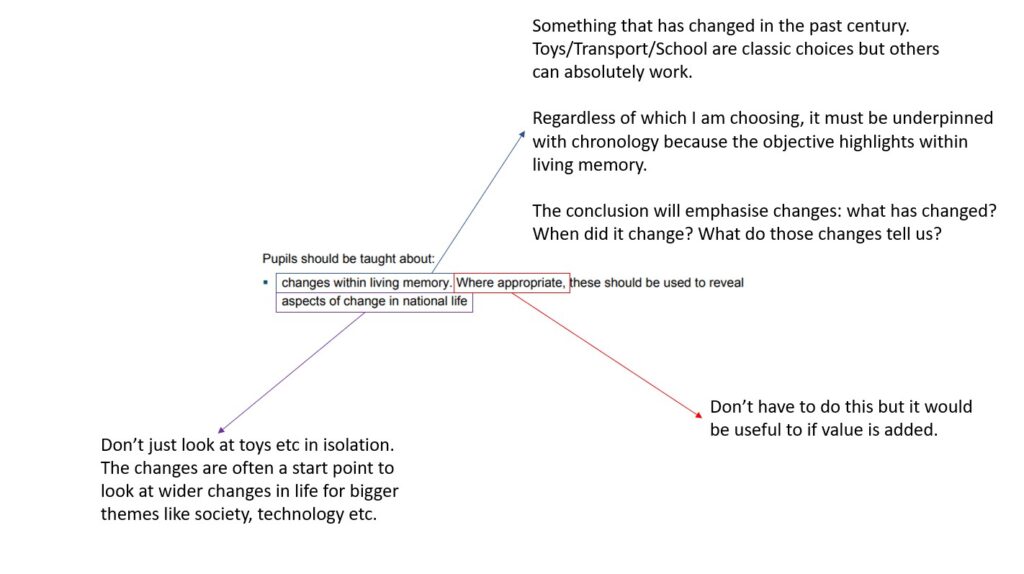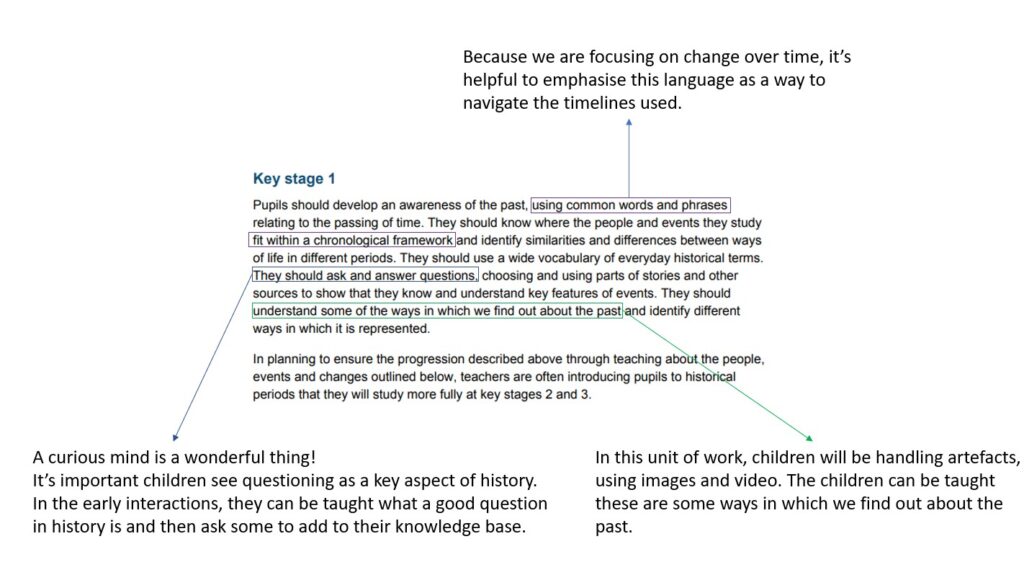There have been a number of teachers asking on social media about what to do for their next history topic. I thought I’d collate some ideas I tend to suggest and some choices I tend to avoid. In no way shape or form is this an attempt to denigrate those that approach history differently so please see this as one of many possible guides – there is no singular way to teach history.
The sequence of thinking I tend to work through when planning a new sequence. The * steps are ones that may or may not be possible, workable depending on school context.
First, panic! Then, focus on deliberate choices to be made! A scattergun approach leads to isolated episodes and less of a coherent sequence.
What does my school’s LTP say? Many schools have spent enormous amounts of time developing their curriculum over the previous few years and it is more prescribed than once was the case. If there is existing planning in place, read it through and consider what it emphasises and the knowledge to be taught. At this stage, resist the urge to focus in on activities. Let’s first emphasise what the children will learn.
What does the National Curriculum say? Read the objective carefully then read it again. What is the nuanced detail? This is key because most objectives offer a clearer starting point than we may imagine. My response to this twitter post followed this line of thinking. NB – check existing planning fulfils this NC specification. It’s important either way!

The wider NC document is something to read when planning. The wider document offers support in terms of the breadth of what is to be covered. The paragraph below is above the bullet point and includes the range of processes and skills children should encounter, develop as they progress through the Key Stage.

Read around to get a feel for the nature of what life was like at the time or what could be learned. BBC Bitesize (KS3 and GCSE are often helpful for teacher knowledge), BBC history, Michael Tidd’s history cheat sheets, Historical Association website including magazine etc. The purpose here isn’t to specify exactly what will be emphasised yet but rather to dip a toe into possibilities. Often, things have caught my attention at this stage and something I’ve developed further when constructing subsequent enquiries or as sources of evidence within one stage of an enquiry.
Construct an enquiry question. This is a historically valid question which guides a sequence of lessons with a clear focus on adding lots of knowledge in order to be able to genuinely answer the question at the end. In addition, it will emphasise the discipline of history so lessons include an aspect of thinking or working like a historian (aims 4 and 5 of the National Curriculum).[i]
For the topic on toys, I’d start with:
a) How have toys changed in the last century?
b) What do those changes tell us about the way people live?
Here, enquiry a is going to be longer than b. It will do more of the heavy lifting in terms of knowledge acquisition. B focuses on drawing conclusions and adding breadth to what enquiry A has done.
For more information on this, download the Historical Association’s enquiry toolkit which is free access with website signup (no payment needed).
This is useful because it enables teachers to distinguish between core knowledge and that which adds little value. Everything children will learn adds value to enquiry a, b or both.
Presenting what is to be learned on a relevant timeline. I’ve written on chronology a number of times, which can be found here on my blog and teachwire. There are a number of explanatory videos on my Youtube channel too.
Have the children encountered these concepts or ideas before?* It’s important to think about the knowledge children will arrive with based on the taught curriculum from EYFS etc. This will be broadened by experiences some children will have from home but this can’t be guaranteed for many.
Now, think about which toys are going to be studied. The enquiry question mentions change but implied is studying some which remain relatively unchanged since they were first launched. A mixture is important so as not to misrepresent the past. I’d personally choose toys that will capture the interest of children and that they can interact with.
My choices:
– teddy bears/dolls
– construction toys like lego
– computer game consoles
The risk here could be to overload the children with too many options. This could so easily make it harder for them to spend sufficient time learning about the story of each of the toys and reduce the likelihood of them remembering more of the substantive knowledge about them.
Substantive knowledge – Ofsted defined this as “their knowledge about the past” in the recent research review[ii]. This is where teachers must make choices! Define the knowledge you want children to know and remember from this unit of history.
How will they learn it? Now the knowledge is clear, think about how the children will acquire it. For KS1, the children may still be based predominantly in areas of provision which impacts the nature of the task. At the end of each stage of the enquiry, bring the children together and ask them what they have learned in relation to the enquiry question. It’s what the knowledge is going to be hung onto. Be careful though, focus on what has been learned and not on what they did.
I call these summaries of learning and find them useful as a formative assessment tool. Children may discuss them collaboratively and produced a word or sentence level answer. This could be spoken or written as either medium is totally valid. A summary picture is a useful cue for further conversation…
What conclusions will they draw? Once again, the role of the enquiry question(s) is key. The children should, to quote the NC2014, “use a wide vocabulary of everyday historical terms. They should ask and answer questions, choosing and using parts of stories and other sources to show that they know and understand key features of events.” To me, this is not an over-scaffolded essay which essentially recites everything the child has learned. Rather, a carefully considered selection of evidence that illustrates the point with a clear conclusion.
In the particular toys enquiry, it could be something like this for enquiry a:
Some toys have changed a lot in the last century and some have not. Computer games were only invented in 1972 when my Grandad was a boy and have changed a lot since then. Other toys have not changed much at all. I have a teddy and it looks the same as the first one.
This highlights the child has learned there are examples of continuities and changes. As a source of evidence for teaching, the child has chosen relevant examples and used them carefully. This could be built on for enquiry b by focusing on examples which reveal technological and societal changes.
The example I have in mind is changes in computer games consoles. The child could compare the quality of the technology by thinking about the graphics, range of actions etc. In a societal sense, they could look at the number of people who have access to them now compared to when they were first launched. A caveat though – be mindful of children’s home experiences as some children may have access to very little and focusing on this is not a pleasant experience for them.
This is an introductory guide that I put together for newer teachers. The structure hopefully guides them in thinking about a sequence of thinking. In no way, shape or form, is this a definitive list (see below) of implications that can affect what is chosen to be taught. Any questions, please do drop me a tweet, Facebook message or email and I’ll happily chat further.
What I didn’t include but would think about as a more experienced teacher:
- Which substantive concepts are run through the curriculum.
- Is this a diverse and representative unit of work that shows a range of stories and experiences (think ethnicity, social class, gender roles, disability, LGBT etc).
- Inter-disciplinary links I can make that add valuable hinterland breadth to the children’s understanding.
- How specific sources of evidence can act as a core depth study within an overall enquiry.
[i] https://onebighistorydepartment.files.wordpress.com/2018/01/into_the_history_garden.pdf
[ii] https://www.gov.uk/government/publications/research-review-series-history/research-review-series-history#:~:text=Progress%20in%20history,-Pupils%20make%20progress&text=their%20knowledge%20about%20the%20past,described%20as%20’disciplinary%20knowledge‘)
